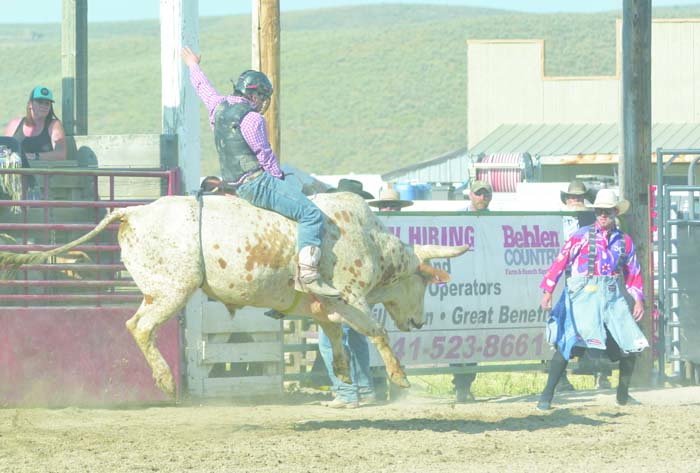Baker County history: Exploring the history of Israel David Haines, for whom the city of Haines was named
Published 9:13 am Monday, June 17, 2024

- Rodeo 6.jpg
Oregon has a fabulous history. If you are interested in where to read about Oregon’s history, there’s no better place to start than in the Oregon Room of the Baker County Library District, which is located on the Powder River side of the building at 2400 Resort St. in Baker City.
As the name of the room implies, it’s chock full of information about Oregon’s history.
In searching for information about I.D. Haines, I looked in “The Centennial History of Oregon, 1811-1912,” four volumes by Joseph Gaston, located in the Oregon Room. These are thousand-plus-page leather-bound tomes published in 1912.
Volume 1 contains a very detailed history of Oregon starting with Columbus sailing west in 1492 expecting to find the Asian continent. Next, Gaston tells about the many European mariners who beginning in the early 1500s sailed through Magellan Strait at the southern tip of South America and then north along the west coast of South and North America, some of them searching for a mythical Northwest Passage as a shortcut to the Atlantic Ocean and Europe.
The most important mariner in Oregon history was Captain Robert Gray (1755-1806) of Boston, famous for his discovery of the Columbia River in 1792. But first, a few words about Gray’s first voyage to the Pacific Ocean (1787-1789).
Gray was the first American to sail along the coast of Oregon. His first glimpse of Oregon was on Aug. 2, 1788, as his ship sailed past the 42nd parallel, present border between California and Oregon. Twelve days later Gray was the first mariner to anchor a ship in an Oregon harbor, Tillamook Bay. Gray sailed farther north as far as Vancouver Island, where he spent the winter engaging in buying otter furs from the Indians. By the end of 1789, Gray was back in Boston.
On Sept. 28, 1790, Gray left Boston harbor for a second voyage to the Pacific, this time in a ship named Columbia. Sailing close to the coast of Oregon, Gray discovered a flow of water from a large river. After spending nine days attempting to get over the bar, Gray continued north, arriving at Vancouver Island on June 5, 1791.
Gray explored along the east side of Vancouver Island, then wintered over at Clayoquot village. On April 2, 1792, Gray pulled up anchor and headed south for the long voyage back to Boston.
On May 19, 1792, Gray was again at the outflow of a very large river. The log book of the Columbia described the successful crossing of the Columbia River bar.
“At four o’clock in the morning of the 11th we beheld our desired port, bearing east-southeast, distance six leagues (21 miles). At 8 a.m., being a little to the windward of the entrance of the harbor, bore away, and ran in east-northeast, between the breakers, having from 5 to 7 fathoms (30 to 42 feet) of water. When we were over the bar, we found this to be a large river of fresh water, up which we steered. Many canoes came along side.”
Gray traded with the Indians for a few days and explored about a dozen miles up the river he christened Columbia before continuing his voyage home to Boston.
We look now at the content of volumes ll, lll, and lV, which contain over 500 biographies submitted by Oregonians. My assumption is that the volumes are what one may term “vanity” volumes for which one paid to have one’s biography, and sometimes a full-page photo portrait, included in one of the three volumes.
I found the biography of I.D. Haines on pages 172-177 of Volume ll. Library staff have listed on sheets in an envelope the names of many Baker City and County citizens whose biographies are included in the three biographical volumes.
Like many Oregonians of his generation, Israel David Haines, the object of this short biography, began life a thousand or more miles away in the “states” long before Oregon even became a territory.
He was born on Sept. 7, 1827, in Xenia, Ohio, 15 miles southeast of Dayton. His parents were Reuben Haines (1803-1874) and Nancy (Connelly) Haines (1807-1836), who were natives of Augusta County, Virginia. Census records reveal that Israel was 8 when his mother Nancy died. Israel’s father remarried but I’ve not found who his second wife was. In 1844, when Haines was 15, the family moved to Macon County, Missouri, about equal distant north of St. Louis and Kansas City.
On June 15, 1846, the United States and Great Britain signed the Treaty of Oregon ending 28 years of joint occupancy of the Pacific Northwest. The treaty established the 49th parallel as the border between the two countries.
In 1848 Congress created the Oregon Territory, comprising the future states of Oregon, Washington and Idaho, and two small parts of western Montana and Wyoming.
In the spring of 1849 Israel, age 21, and older brother Robert, 23, happened to be in Hannibal, Missouri, on the Mississippi River, where news had arrived about the rich gold strike in California. They began making plans to join a wagon train of like-minded opportunists headed for the California gold fields.
In Israel’s memoir, he recounts finding out there was an alternative way to get to the mines in California, whereby the two brothers could be paid to travel the over 2,000 miles to the West Coast. The brothers jumped at the chance.
On April 23, 1849, Israel and Robert joined a thousand-man U.S. Army rifle regiment headed for Vancouver in the new Oregon Territory. The regiment’s task was to take charge of the territory ceded by Britain south of the 49th parallel, which to this day is the boundary between Canada on the north and the states of Washington, Idaho, Montana, and North Dakota on the south.
Following are several excerpts from Israel Haines’ memoir about his experiences after the regiment crossed over the Rocky Mountains.
“How well I remember coming to Green River, and then over to Bear River, and across the divide over to Snake River at Fort Hall (near today’s city of Pocatello, Idaho), where we turned in seventy-five wagons, and left some troops and mules; and (I) well remember coming on, down around the bend of Snake River through Idaho, and into Oregon, then known as Oregon territory. … ”
“And well do I remember coming into Powder River Valley about the first of September, 1849. The rye grass in this valley was so high that when we turned our mules out we had trouble in finding them, for at that time we had, after leaving those at Fort Laramie and Fort Hall, about three thousand animals, consisting of horses, mules and cattle. We camped here and all went fishing for trout in Powder River and Chris Hinkler’s (Baldock’s) Slough. We had with us some Freiberg mineral experts, who prospected for gold on the Chris Hinkler Slough and also on the North Powder River. …”
“When the military units reached The Dalles, four men put together a raft determined to reach Vancouver via the Columbia River, rather than taking the Barlow Road over the Cascade Mountains. The boat capsized in going over Celilo Falls. …”
(Two of the four-man crew declined to brave the falls. The other two men’s bodies washed all the way down to Fort Vancouver.)
“Our regiment left Fort Leavenworth (Kansas) on the 10th day of May, 1849, and arrived at Oregon City on the 10th day of October, 1849; completing a distance of two thousand, three hundred and sixty miles. Cholera and desertions had reduced the regiment from one thousand to a little over three hundred men.”
Israel was laid low with cholera for a couple of weeks but survived. Brother Robert, in a separate company drove an ambulance. He loaded and unloaded many cholera-infected men, but never contracted the disease.
Israel continued: “On the last lap of our journey in Uncle Sam’s service to the great Oregon country we crossed the Columbia at Switzlers (Switzer’s) ferry, entered Fort Vancouver, Washington, and took charge of the same pursuant to the treaty with Great Britain. Vancouver was the main headquarters of the Hudson’s Bay Company, extending to the 49th parallel north latitude. Brother Robert and myself were discharged and paid off with Mexican dollars and doubloons, there being no United States coin in this country at that time.”
“Judge” Israel David Haines, 1827-1892, donated 110 acres, about 10 miles north of Baker City, where the city of Haines was platted. This is the first of two stories about Israel Haines written by longtime Baker County historian Gary Dielman. The second part will be published in the June 25 issue.





